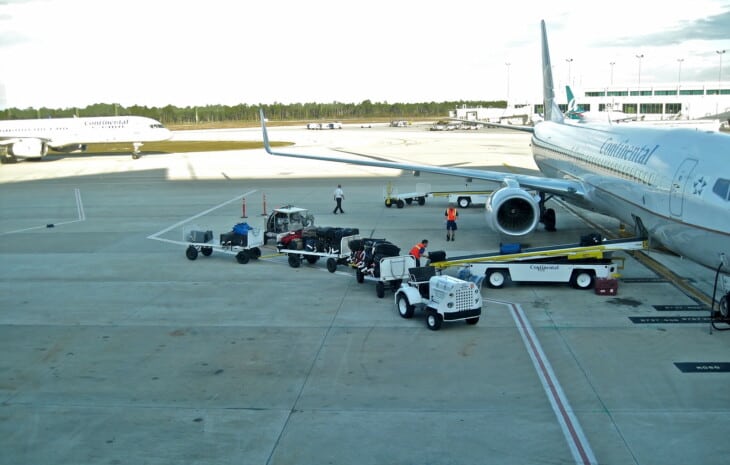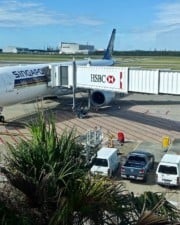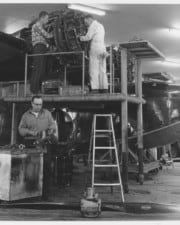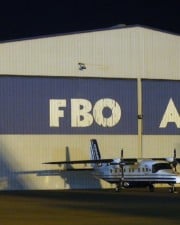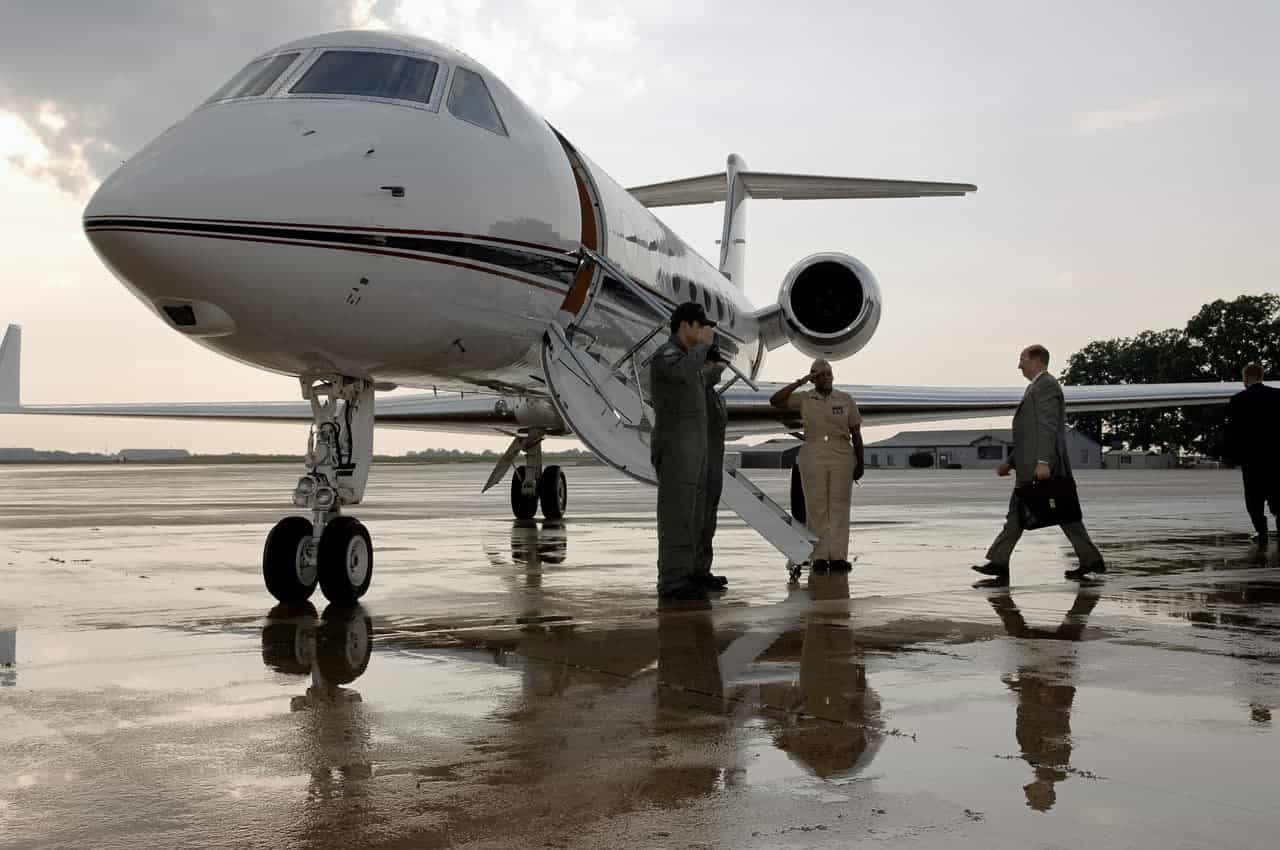If there’s one thing aviation’s full of, it’s acronyms. Pretty much everything has one. But arguably none are more important, to both pilots and non pilots alike, than GSE. That’s because they are arguably what keeps the airfield – no matter if it’s one of the world’s largest or one of the smallest – running smoothly and without delay. But what exactly is GSE?
In aviation, GSE stands for Ground Support Equipment. That is, all the ground equipment seen on the apron at airports, which is used to service airplanes between flights. That can include electric power, tow trucks, passenger buses, baggage handling, fueling, catering, waste tank drainage and anymore.
Types of Ground Support Equipment (GSE)
Ground Support Equipment is used to service both civil and military airplanes while on the ground. There are many different types of GSE, each with its own specific function. GSE falls into two broad categories: Powered and Non-Powered.
Powered Equipment
Power Units
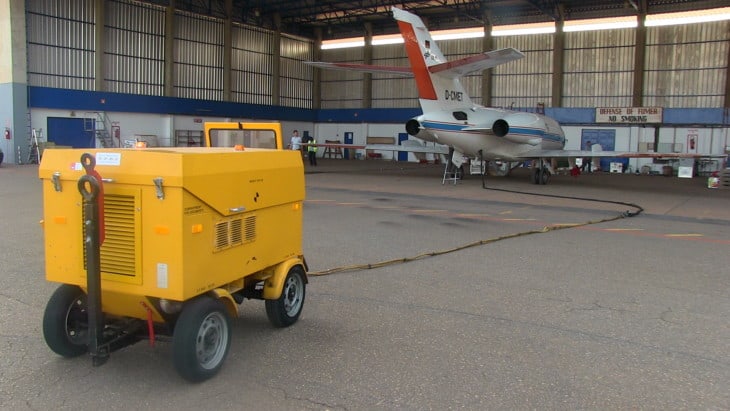
When a passenger airliner arrives on stand, once the pilots have shut down the engines and cleared the ground crew to start work, one of their first actions will be to connect external ground power.
This allows the pilots to shut down the aircraft’s auxiliary power unit (APU) – on most airliners, a small jet engine located in the tail. The APU is usually started after landing, before the airplane reaches the gate, so that electric power is still available after main engine shutdown.
However, most airlines and airports have policies for the duration of APU use. It is essential to connect to ground power before shutting down the APU, or there will be no cabin lighting (except emergency lighting) and no power for aircraft systems.
Pre-Conditioned Air Units (PCA)
While deplaning, passengers might notice two large-diameter hoses attached to the underside of the airplane. These are pre-conditioned air (PCA) units that supply air to the cabin. It is more economical to use pre-conditioned air than to use ground power to drive the airplane’s internal air conditioning.
Once the APU has been shut down, the aircraft has no on-board power to drive the air conditioning packs, so disembarking passengers would quickly notice the air becoming foul if no PCA was connected.
Start Carts
A start cart or huffer cart is an alternative means of starting a jet engine if no on-board bleed air is available to the aircraft. Bleed air can come from the APU, or from another of the aircraft’s engines, if it is running.
On some older airliners, the APU is capable of generating electric current to drive lighting and cockpit systems, but does not produce enough power to run the air conditioning packs or start an engine. On such an airplane, the flight crew will normally start one engine on stand, before pushback.
Accordingly, the ground service crew will connect a start cart to the engine, and follow the instructions of the flight crew to get the engine started, once startup clearance has been received.
There are three types of start cart: those that store compressed air; those with a diesel-powered compressor, and those with gas turbines. In all cases, the start cart provides a high-volume flow of air at low pressure, delivered by hose pipes to the engine, to start the N2 compressor fan rotating.
De-Icing And Anti-Icing Vehicles

In icing conditions, a build-up of ice on wings and control surfaces can be catastrophic to an aircraft, disrupting the flow of air and rendering the airplane unflyable. Therefore, de-icing is a must, if there is any chance of ice forming.
A de-icing vehicle consists of many large tanks of de-icing fluid, surmounted by a movable, hinged boom that allows the operator to access all parts of the airplane’s exterior.
The operator follows a predetermined pattern for each aircraft type, making sure not to damage the control surfaces or accidentally blast them into a different trim position.
De-icing fluid consists of either ethylene glycol or propylene glycol, mixed with wetting agents and surfactants to make it adhere to the airplane.
If the de-icing fluid were to run off too quickly, the de-icing process would be ineffective, as ice and snow could again build up on the aircraft before departure. Depending on conditions, the holdover time before de-icing has to be repeated is usually between 1 and 22 minutes.
De-icing vehicles can move around to service airplanes that are on stand at their gates. Alternatively, at busy airports, there are fixed de-icing stations which are usually located near runway entry points, so airplanes can be de-iced immediately before they depart.
Aircraft Rescue and Firefighting Vehicles
This is a non-routine ground service, but an extremely important one. Should an emergency arise, the speed at which firefighters and rescue services respond can make a huge difference to the survivability of an accident.
All FAA Part 139 certified airfields must have fire fighting services in place, with regular response time drills and recurrent training. Firefighting personnel generally have other duties, such as baggage loading and security services, since actual fire fighting events are thankfully rare.
After a crash, particularly if it occurs on departure, when airplanes have their maximum fuel load, fire and smoke can become a life-threatening hazard to those on board the aircraft within seconds.
If an aircraft declares an emergency before arrival, fire tenders will routinely be deployed to follow the airplane down the runway after touchdown, to be ready to respond instantly should a fire break out.
Fire crews also routinely perform aircraft brake inspections after non-normal landings, before the airplane is allowed near the terminal building.
In the event of a landing with one or more engines out, the brakes absorb more energy than usual, because reverse thrust is reduced or unavailable.
Pushback Tugs And Tractors

Next time you board a commercial flight, take a look toward the airplane’s nose wheel if you can see it from the airport window or the jet bridge. Chances are, you’ll see a low, cuboid-shaped vehicle with enormous wheels.
That’s the pushback tug, which is basically an extremely powerful diesel engine with a wheel at each corner. The tug is weighted to provide traction, and geared to provide sufficient force to move a 360-ton Boeing 747 back from its stand on the taxiway.
When the airports’ ground controller grants pushback clearance, the ground engineer verifies that all ground equipment is removed, and asks the flight crew to release the aircraft’s parking brake.
The ground engineer communicates with the flight deck by plugging a headset into a socket on or near the nose gear.
Part of the ground crew’s job is to insert a bypass pin into the nose gear, disconnecting the nose wheel steering from the aircraft’s hydraulic system.
This allows the driver of the pushback tug to control the steering of the airplane during pushback, rather like a car driver maneuvering a trailer.
Usually, the ground engineer will verify to the flight crew that they are clear to start the main engines during the push. This saves time, and allows the airline to be ready to taxi as soon as the two trucks have been disconnected and is clear.
Also, as mentioned earlier, sometimes one or more engines are started on stand. The ground engineer walks with the aircraft as it pushes back, monitoring all extremities of the airplane during the push and watching for unexpected obstructions.
Finally, the ground engineer communicates to the flight crew that the pushback tug is clear, and the nose gear bypass pin is removed (the engineer will show this pin to the flight crew, to verify).
After that, the engineer unplugs the headset and the airplane is now on its own, disconnected from all ground services.
As well as the pushback tug, smaller tractors are also available, to move any ground equipment that cannot move itself, such as dollies (see below).
Refueling Trucks

Before almost every flight, fuel must be uplifted into the aircraft’s tanks. One possible exception is during a series of short flights, when an arriving aircraft may already have sufficient fuel load for its return leg, to minimize turnaround time and airport charges.
There are two main types of fuel truck. One type is a bowser, that is filled up at the airport’s fuel farm, then drives to the airplane’s stand and pumps the fuel up into the fuel tanks.
From the truck’s point of view, this is quite a time-consuming way of operating, because the truck has to be filled before it can provide fuel to an airplane, reducing the number of refueling cycles it can accomplish in a day.
Many airports today have a more modern system, with fuel pipelines running from the fuel farm to each stand. If you look carefully at the ramp surface at a major airport, you may see small, circular hatches in the concrete surfaces, clearly marked with red rectangles. These are the fueling hydrants.
Again, a fuel truck is needed, but one without its own tank. The truck houses a pump, which draws fuel from the hydrant and forces it up into the airplane’s tanks.
The amount of fuel required is calculated by the flight crew, based on route distance, weather, payload, minimum reserve fuel, and distance to their alternate destination.
Buses
Many airports have passenger aircraft stands that are remote from the terminal building. Therefore, shuttle buses are needed to transport passengers to and from their airplane.
These vehicles are usually designed for standing passengers, holding onto rails, poles and straps, with a few seats for elderly or infirm travelers.
Security personnel ensure passengers do not stray into restricted areas, and pass directly between terminal building and bus, and between bus and airplane.
Jet Bridges and Passenger Boarding Stairs

Either a jet bridge will be moved to connect with a door on the left side of the airplane – usually the L1 or L2 door – or air stairs will be driven into position if no bridge is available.
Passenger boarding stairs look rather like small trucks with staircases on the back. They are carefully positioned, with the stairways able to telescope so that the top landing of the staircase aligns with the door sill of the airplane.
The reason that passengers always board and disembark on the left side is because the right side doors of the airplane are reserved for catering trucks and baggage handling services.
Belt Loaders
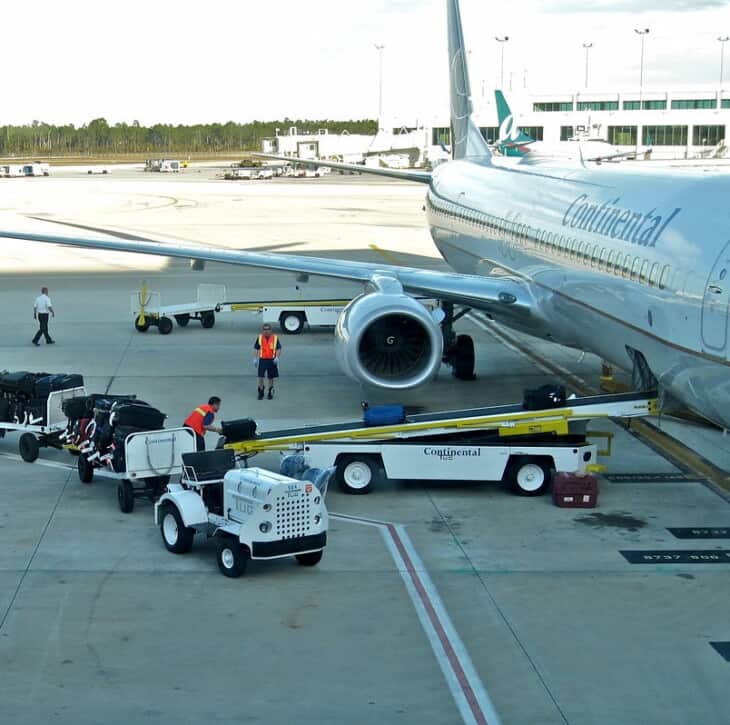
Baggage unloading quickly gets under way after engine shutdown. On a mid-sized airliner such as a Boeing 737 or Airbus A320, baggage handlers enter the hold and manually place bags onto a belt loader.
Container Loaders
On larger jets, like the 787 or A330, Cargo Unit Load Devices – aluminum baggage containers – are rolled onto a container loader, which then lowers each container almost to ground level, where it can be moved onto a dolly.
Water Trucks
Non-potable water for washing hands in the lavatory sinks, and potable water for making hot drinks in the galley, are delivered to the aircraft by truck and pumped into the relevant tanks.
Toilet Service Vehicles
During turnaround between flights, waste from the aircraft’s sewage tank is pumped aboard a tanker, to be taken away for treatment and disposal.
The airplane’s sewage tank is then partially refilled with ‘blue juice’, a mixture of bio-based disinfectant and water, which deodorizes waste and kills bacteria.
Catering Vehicles
While they might not be cordon bleu, those airline meals break up a flight and give us a sugar boost. Before every departure, in-flight meals have to be loaded onto the aircraft. On passenger airliners, this is done through the doors on the right side of the airplane.
The cargo area of an airport catering truck is refrigerated and can be maintained at 32°F (0 °C) to prevent deterioration of the food while it is en route from the catering center to the aircraft.
Catering vehicles look like regular trucks, but they have a rear lifting system that can raise the cargo area to the level of the aircraft door sill. Stabilizers are deployed to prevent the trucks tipping over while the rear is lifted. Sideways fine-tuning allows the truck to align exactly with the doorway.
Catering staff and cabin crew can then stow the meals in the galley until they are served, up in the cruise. Unused food from the previous flight is unloaded at this time. The metal carts that we see rolling up and down the aisles are swapped over.
Catering staff take away the previous flight’s carts. At the catering center, within or near the airport, old food will be disposed of, and new meals prepared for subsequent flights.
Kitchens where airline meals are prepared are certified HACCP (Hazard Analysis and Critical Control Points) to ensure the highest standards of hygiene.
By the time the first passengers set foot on the airplane, the catering trucks have gone and the right-side doors have been closed. The galleys are stocked and the cabin is ready.
Non-Powered Equipment
Non-powered GSE is any equipment that cannot move by itself.
Dollies
There are two kinds of dollies.
One kind of dolly is the low-loading metal pallet that carries the Cargo Unit Load Devices used on wide-body airliners like the Boeing 777 and Airbus A330. These dollies are towed in line by a tractor, and the Cargo Unit Load Devices are rolled into the airplane’s hold by a container loader.
The other kind of dolly is known as a baggage cart. It is used to ferry loose baggage from the terminal to smaller airplanes that do not use Cargo Unit Load Devices, such as the 737 or A320. These dollies are enclosed, except for the sides, which are protected by plastic curtains.
Chocks
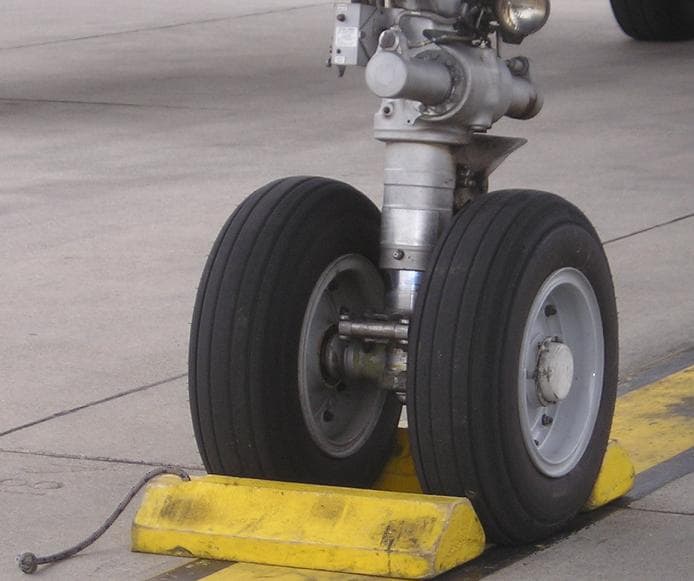
Wheel chocks are placed behind and in front of each wheel of an aircraft when it is parked. The purpose of the chocks is to prevent the airplane from moving. Chocks are wedge-shaped structures, of hard rubber or wood, placed in physical contact with the tyres, and roped together to prevent movement.
Tripod Jacks
An evenly-loaded airplane’s center of gravity is usually somewhere near the main landing gear. During loading and unloading, the center of gravity may shift. At times, therefore, the airplane may be tail-heavy.
If the airplane were to rotate backward while parked on stand, a lot of expensive damage could result, not to mention possible danger to life and limb. Therefore, tripod jacks are used. A tripod jack is placed under the rear fuselage, bracing the airplane against the ground and preventing an uncommanded nose-up rotation.
In this 2014 video clip, you can see a 737 pitch upward on stand, as baggage is offloaded from the forward hold. This would have necessitated a thorough inspection of the L1 door and door frame to ensure they had not been damaged by contact with the jet bridge.
The tail of the airplane would also have had to undergo a rigorous examination, for possible damage caused by impact with the ground. Longer variants of the popular 737 family have a tail skid to protect the airplane’s skin against contact with the runway, should a tail strike occur on landing or take-off.
Passengers were still on board the airplane at the time of the accidental pitch-up. Fortunately, no-one was injured. Had a tripod jack been used, the uncommanded rotation would have been avoided.
Service Stairs
Not to be confused with passenger boarding stairs, service stairs are box-shaped staircases on wheels, designed to allow ground staff to access the underside of a parked aircraft. Ground crew may need to inspect static ports and pitot tubes on the fuselage.
Fueling crew need to be able to reach the fueling points on the undersides of the wings, to attach refueling hoses. Service stairs allow them to do this.
GSE for Corporate Aircraft
The needs of corporate operators are very different from those of passenger and cargo airlines. The latter operate a business model that involves keeping their airplanes in the air for every possible moment.
Companies that operate business jets expect their airplanes to be hangared between flights. As the aircraft they fly are much smaller than commercial airliners, they can store several airframes in a hangar at a time. For that purpose, they need different equipment than that used by the airlines.
Towbarless tugs are one difference. Remote-controlled, they can park corporate airplanes very close together, making best use of space and avoiding disproportionate storage charges for the owner.
GSE for business jets is almost always owned by the third-party company that operates it, typically (one of) the FBO(s) at that airport.
GSE for General Aviation Aircraft
In the GA world, there are no catering trucks, baggage dollies or jet bridges. GSE for light general aviation aircraft comprises avgas pumps for refueling, and tie-down or hangar storage between flights. A fuel sight glass allows inspection of fuel for water or other contamination.
How Much Does GSE Cost?
For a Boeing 737, the total GSE cost for a standard turnaround is estimated to be in the region of $2,000 plus fuel and other consumables.
However, what the airline actually pays will depend upon who owns the GSE that is used. If it’s the airline’s own equipment and staff, that is the best possible deal. Failing that, the airline may have a reciprocal agreement with another airline, whereby they can use each other’s GSE.
De-icing can push up turnaround costs enormously – airlines can expect charges of $1,300 per application for a small jet, and up to $13,000 for larger airframes.
Who Owns GSE?
Large airlines invest millions of dollars in their own GSE, which they can then use without incurring further charges. To offset their costs, they rent out their equipment to smaller airlines.
Additionally, there are ground-based, third party operators who provide GSE to a number of airlines. Some of these such companies may be owned by the airlines (or formerly owned by them) such as Lufthansa and the now-defunct GlobeGround (now a part of Swissport).
Many people think that ground support equipment is owned by the airports where it operates. However, in North America, most GSEs are owned either by an airline, or by the ground handler to which the airlines outsource the work.
In other parts of the world, particularly developing aviation markets in Asia and South America, airports do own some of the GSE employed at their airport, with the shortfall made up by airlines/GSE providers.
How Does GSE Operate on The Airfield?
As soon as an airliner docks at the gate, ground services spring into action. As airplane passengers, we have all heard the clunks and felt the jolts as baggage handlers open the external doors the moment the engines have run down, and begin getting the bags off.
In fact, ground support activities start before the airplane arrives. As part of their apron management, air traffic control at the airport will allocate an arrival gate for the incoming aircraft, depending on its size, availability of gates, and on how the airport is organized.
Many airports have dedicated piers or groups of gates for foreign and home airlines. Once the arrival gate has been decided, the ground support team can start work.
They begin by moving all the required GSE to the designated ramp, and they check it is all serviceable, before the airplane arrives.
Time is of the essence, so everyone feels a sense of urgency. As the aircraft turns onto its stand, either a marshaller will guide the pilot to stop exactly on the line and at the right distance, or that job will be done by an automated display visible through the windshield.
In these post-pandemic days of economic caution, airports cannot afford to carry excess GSE.
Schedulers work hard to maximize efficiency, moving GSE from central parking locations to where it is needed, planning ahead as much as possible to make the best use of the resources and staff they have.
GSE vs ASE: What’s The Difference?
ASE stands for Aviation Safety Equipment. That might sound like a pretty wide-ranging term – after all, aviation is all about safety – but the need for ASE has arisen specifically from GSE. It happened like this.
Commercial aviation is an expensive business. Airlines and corporate business jet providers invest heavily in their aircraft, and they need them in the air, generating revenue, as much as possible. An airliner sitting on the ground is an economic black hole, guzzling funds for no return.
So, it’s in the airlines’ interest to turn airplanes around on the ground as fast as possible between flights. That means there is time pressure on ground staff, and that can lead to mistakes, which may cause expensive damage and costly delays.
For example, fuselage damage can be caused by a jetway or service stairs approaching too fast and colliding with the side of the aircraft. Lavatory service crews can accidentally overfill tanks with ‘blue juice’ disinfectant, harming the airplane’s waste drainage system.
To guard against such accidents, various ASE items have been developed, complementing GSE and increasing safety by reducing the potential for human error.
Examples of this include Aircraft Safe Docking, which uses 3-D sensing cameras to prevent GSE approaching an airplane too fast, which airports claim have helped to reduce GSE-related accidents by as much as 75% over the last few years.
The Safe-Lav system uses a batching tank to protect against accidental over-filling of waste tanks, and is particularly useful to corporate airplanes with fast turnarounds. Other ASE measures the tension in tow bars during pushback or airplane ground movement, to prevent serious damage.
To summarize, whatever piece of GSE we care to name, there is likely a piece of ASE available to reduce the potential for accidents by removing the human error factor.
Related Posts
